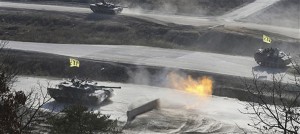Korean border open despite NKorean hotline cut

A South Korean K1 army tank fires live rounds during an exercise at Seungjin Fire Training Field in mountainous Pocheon, South Korea, near the border with North Korea, Wednesday, March 27, 2013. North Korea said Wednesday that it had cut off a key military hotline with South Korea that allows cross border travel to a jointly run industrial complex in the North, a move that ratchets up already high tension and possibly jeopardizes the last major symbol of inter-Korean cooperation.AP / Yonhap, Lim Byung-shick
SEOUL, South Korea — A day after shutting down a key military hotline, Pyongyang instead used indirect communications with Seoul to allow South Koreans to cross the heavily armed border and work at a factory complex that is the last major symbol of inter-Korean cooperation.
Business was operating normally at the Kaesong industrial complex in North Korea, despite Pyongyang’s shutting down of the hotline usually used to arrange passage for workers and goods through the Demilitarized Zone. The military communication channel, which consists of six telephone, fax and reserve lines, was virtually the last remaining direct link between the rival Koreas, which do not have diplomatic relations.
South Korean officials say North Korea has shut down the hotline but verbally approved the crossing Thursday by telling South Koreans at a management office at the factory in North Korea. Those South Koreans then called officials in South Korea. Both governments prohibit direct contact with citizens on the other side, but Kaesong has separate telephone lines that allow South Korean managers there to communicate with people in South Korea.
Technically, the divided Korean Peninsula remains in a state of war. North Korea also halted communications in 2009, creating a cross-border shutdown that left hundreds of South Korean workers stranded in the North for several days, until the line was restored.
The hotline shutdown follows a torrent of bellicose rhetoric in recent weeks from North Korea, which is angry about annual South Korea-U.S. military drills and U.N. sanctions over its nuclear test last month. North Korea calls the drills rehearsal for an invasion; Seoul and Washington say the training is defensive in nature and that they have no intention of attacking.
Article continues after this advertisementNorth Korea’s threats and provocations are seen as efforts to provoke the new government in Seoul, led by President Park Geun-hye, to change its policies toward Pyongyang. North Korea’s moves at home to order troops into “combat readiness” are seen as ways to build domestic unity as young leader Kim Jong Un strengthens his military credentials.
Article continues after this advertisementNorth Korea previously cut Red Cross phone and fax hotlines with South Korea, and another communication channel with the U.S.-led U.N. command at the border between the Koreas. Three other telephone hotlines used only to exchange information about air traffic were still operating normally Thursday, according to South Korea’s Air Traffic Center.
North Korea said there was no need for communication between the countries in a situation “where a war may break out at any moment.”
In Washington, U.S. State Department spokesman Patrick Ventrell told reporters that North Korea’s “latest threat to cut off communication links coupled with its provocative rhetoric is not constructive to ensuring peace and stability on the peninsula.”
Although North Korea has vowed nuclear strikes on the U.S., analysts outside the country have seen no proof that North Korean scientists have yet mastered the technology needed to build a nuclear warhead small enough to mount on a missile.
Park so far has outlined a policy that looks to re-engage North Korea, stressing the need for greater trust with North Korea while saying Pyongyang will “pay the price” for any provocation. Last week she approved a shipment of anti-tuberculosis medicine to the North.
Aside from Kaesong, other rapprochement projects created during a previous era of detente, including the reunions of families separated by the Korean War and tours to a scenic North Korean mountain, have stopped amid tensions in recent years.
But the border was still open Thursday. About 160 South Koreans traveled to the Kaesong complex from the South, according to Seoul’s Unification Ministry. The total number of South Koreans at Kaesong on Thursday was more than 1,000.
“Nothing good happens when (the Koreas) are in conflict. I just hope that both the North and the South will maintain a good relationship and show a more harmonious attitude,” Kim Jong-in, one of the South Korean workers, told The Associated Press in Paju, which is near the border, on Thursday before departing for Kaesong.
Since 2004, the Kaesong factories have operated with South Korean money and know-how, with North Korean factory workers managed by South Koreans.
Using North Korea’s cheap, efficient labor, the Kaesong complex has produced $470 million worth of goods in 2012. Inter-Korean trade, which includes a small amount of humanitarian aid sent to the North and components and raw materials sent to Kaesong complex to build finished products, amounted to nearly $2 billion in 2012, according to South Korea’s Unification Ministry.